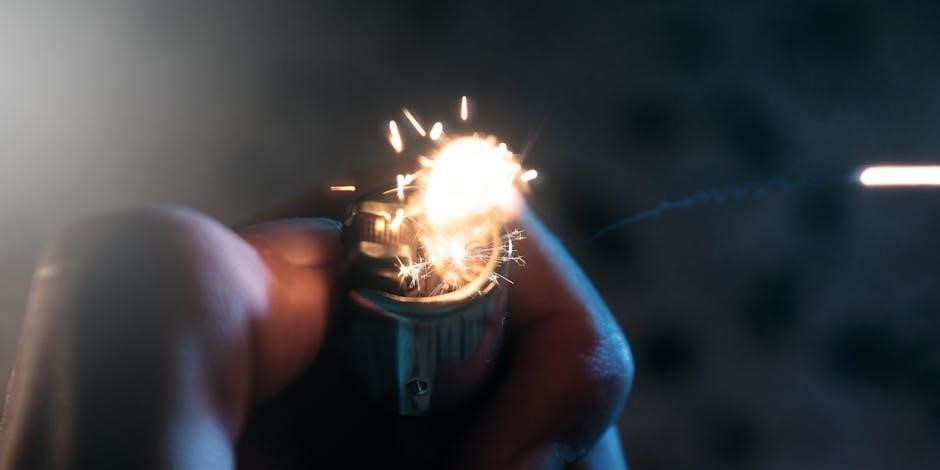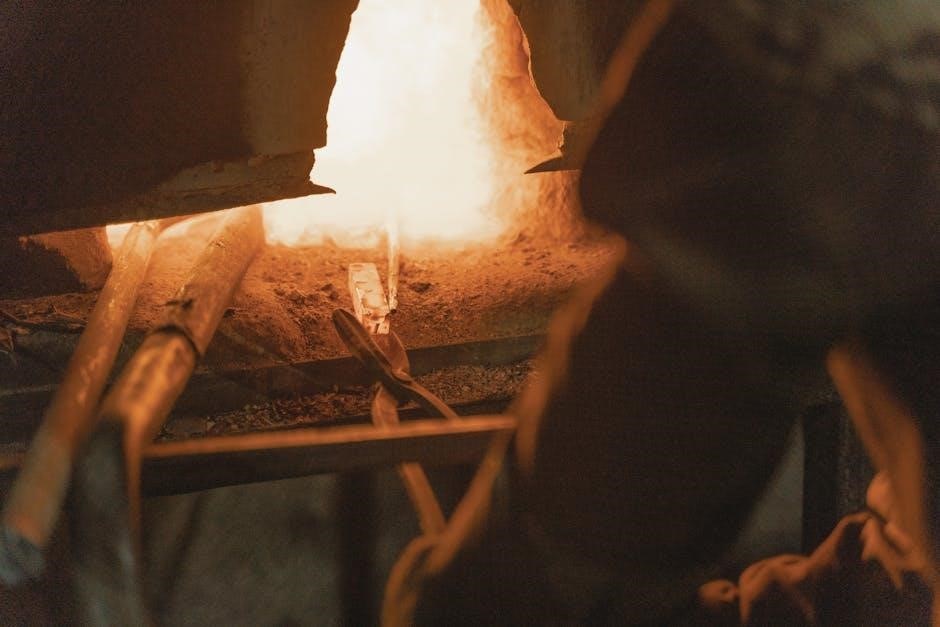firex fire alarm manual
FireX fire alarm systems are renowned for their reliability and advanced features, ensuring comprehensive fire detection and alerting solutions for residential and commercial spaces.
Overview of FireX Fire Alarm Manual
The FireX Fire Alarm Manual is a comprehensive guide providing detailed instructions for installing, configuring, and maintaining FireX systems. It covers key safety features, system components, and troubleshooting tips, ensuring optimal performance. The manual emphasizes compliance with fire safety standards and offers practical advice for users to prevent false alarms. By following the manual, users can ensure their FireX system operates efficiently, safeguarding lives and property from fire hazards. It serves as an essential resource for both professionals and homeowners seeking reliable fire protection solutions.
Importance of Fire Safety Systems
Fire safety systems are crucial for protecting lives and property from fire-related disasters. They provide early detection, enabling timely evacuations and minimizing damage. According to recent incidents, fires caused by arson, electrical faults, and unattended hazards highlight the need for reliable systems. FireX systems, as outlined in their manual, offer advanced detection and alerting features, ensuring rapid response to potential threats. Proper installation and maintenance of these systems are vital to prevent tragedies, emphasizing their role in safeguarding communities and reducing fire risks effectively.
Key Features of FireX Fire Alarm Systems
FireX fire alarm systems are renowned for their advanced detection capabilities, reliability, and adaptability. They feature multi-sensor technology, which combines smoke, heat, and carbon monoxide detection for comprehensive protection. These systems offer seamless integration with smart home devices, remote monitoring, and customizable alerting options. Their user-friendly control panels provide real-time status updates and intuitive controls. With scalable designs, FireX systems cater to both residential and commercial needs, ensuring optimal fire safety. Their robust construction and compliance with international safety standards make them a trusted choice for reliable fire protection.

System Components and Accessories
FireX systems include control panels, smoke and heat detectors, manual pull stations, sirens, strobe lights, and wiring accessories, ensuring reliable fire detection and alerting capabilities.
FireX Smoke Detectors: Types and Features
FireX smoke detectors are designed to provide early detection of fires, offering ionization and photoelectric models. Ionization detectors excel at identifying fast-flaming fires, while photoelectric models are better at detecting smoldering fires. Both types feature advanced sensors for reliable detection. Additional features include hush buttons to silence false alarms and LED indicators for low battery or fault conditions. Some models are wire-in, while others offer battery-powered convenience. Interconnectivity allows multiple detectors to communicate, ensuring comprehensive coverage. These detectors are essential for enhancing fire safety in residential and commercial settings.
FireX Heat Detectors: Functionality and Benefits
FireX heat detectors are designed to detect rapid temperature increases or exceedance of a preset threshold, providing early warning of potential fires. They are ideal for areas where smoke detectors may not be suitable, such as kitchens or garages. These detectors offer two main types: fixed temperature and rate-of-rise models. Fixed temperature detectors activate when a specific temperature is reached, while rate-of-rise detectors trigger an alarm if the temperature increases rapidly. Both types ensure reliable fire detection, reducing false alarms and enhancing safety in high-risk environments.
FireX Carbon Monoxide Detectors: Integration with Fire Alarms
FireX carbon monoxide (CO) detectors are designed to integrate seamlessly with FireX fire alarm systems, enhancing overall safety. These detectors monitor CO levels and trigger alarms when dangerous concentrations are detected. Integration allows centralized monitoring and control, ensuring unified emergency response. When CO levels rise, the system activates alerts via sirens and strobe lights, coordinating with fire alarms for comprehensive protection. This combination provides early warnings for both fire and CO threats, safeguarding occupants and complying with safety regulations. The integrated system ensures efficient and reliable protection against multiple hazards.
FireX Manual Pull Stations: Design and Operation
FireX manual pull stations are critical components of fire alarm systems, designed for quick activation in emergencies. These stations feature a durable, tamper-proof design with a visible red handle or lever. When pulled, they trigger the fire alarm, alerting occupants and first responders. The stations are typically wall-mounted and easy to access, ensuring rapid response. They operate on a simple mechanical mechanism, providing reliable activation. FireX pull stations are designed to integrate seamlessly with the overall fire alarm system, enhancing safety and compliance with fire safety standards. Regular testing is essential to ensure proper functionality.
FireX Sirens and Strobe Lights: Alerting Devices
FireX sirens and strobe lights are essential alerting devices in fire alarm systems, ensuring quick notification during emergencies. These devices provide both audible and visual alerts, making them ideal for noisy environments or for individuals with hearing impairments. FireX sirens produce high-decibel sounds, while strobe lights emit bright, pulsating flashes. They are designed to be wall or ceiling-mounted and are built with durable materials for long-lasting performance. These devices are fully compatible with FireX control panels and can be programmed for synchronized operation. Their adjustable settings allow customization to meet specific safety requirements, ensuring effective emergency response. Regular testing is recommended to maintain reliability.

Installation and Wiring Guidelines
Proper installation and wiring of FireX systems ensure reliability and compliance with fire safety standards. Plan carefully, follow local codes, and test thoroughly post-installation.
Pre-Installation Checklist for FireX Systems
Before installing FireX systems, review local fire codes and building plans to ensure compliance. Assess the layout for optimal device placement and wiring routes. Verify power supply requirements and compatibility with existing systems. Check sensor types needed based on the environment. Ensure all components, including detectors, panels, and wiring, are available. Review the manual for specific installation instructions. Prepare tools and test equipment. Confirm network integration requirements if connecting to smart systems. Plan for backup power sources and emergency protocols. Ensure proper grounding to prevent interference and ensure system reliability.
Step-by-Step Installation Process
Begin by powering off the FireX system at the main electrical panel. Mount the control panel in a central location, ensuring easy access. Install smoke and heat detectors in strategic areas, such as bedrooms, kitchens, and hallways, following the manufacturer’s height and spacing guidelines. Connect all wiring according to the manual, ensuring secure connections. Test each device individually to verify functionality. Program the system settings, including zones and sensor sensitivity, as outlined in the manual. Finally, conduct a full system test to ensure all components operate seamlessly together.
Wiring Requirements and Recommendations
FireX systems require 12V or 24V DC power supplies, with wiring gauges between 18AWG and 22AWG for signal circuits. Use shielded cables for data lines to prevent interference. Ensure all connections are secure and crimped properly to avoid signal loss. Follow color coding standards for consistency. Ground the system to prevent electrical noise and ensure compliance with safety standards. Keep wiring away from high-voltage lines and heat sources. Double-check connections before powering on. Refer to local electrical codes for additional requirements. Proper wiring ensures reliable system performance and safety. Always test connections before final installation.
Mounting FireX Devices: Best Practices
Mount FireX devices in compliance with NFPA 72 regulations and local fire codes. Ensure smoke detectors are centered and at least 4 inches away from walls or ceilings. Heat detectors should be mounted 4-6 inches below the ceiling. Use approved screws or clips for secure installation. Avoid areas with obstructions or extreme temperatures. Level the devices during installation to ensure proper operation. For wall-mounted devices, maintain a distance of 12 inches from corners. Test devices post-installation to confirm functionality. Follow manufacturer guidelines for optimal performance and reliability.

Configuration and Programming
Configure and program FireX systems to meet specific needs. Set detection zones, customize settings, and integrate with security systems. Ensure proper setup for reliable operation.
Setting Up FireX Control Panels
Setting up FireX control panels involves connecting detectors, sirens, and other devices to the main hub. Ensure all wiring is secure and follows the manual’s guidelines. Initialize the panel by entering the system configuration menu. Set parameters like detection sensitivity, alarm delays, and zone assignments. Proper setup ensures reliable performance and accurate alerts. Always refer to the FireX fire alarm manual for specific instructions tailored to your system model. Correct installation is crucial for safety and compliance with fire codes.
Configuring Detection Zones and Sensors
Configuring detection zones involves mapping specific areas to sensors in the FireX system. Start by defining zones based on building layout and sensor types. Assign each smoke or heat detector to a zone via the control panel; Set sensitivity levels for accurate detection. Label zones clearly for emergency response. Ensure proper synchronization between sensors and the panel for reliable alerts. Follow the FireX manual for zone configuration steps to optimize system performance and ensure all areas are adequately monitored for fire safety.
Programming FireX System Settings
Programming FireX system settings involves customizing parameters to meet specific needs. Access the control panel to set system-wide configurations, such as alarm delays, sensitivity levels, and notification protocols. Define zones and assign devices to each zone for precise monitoring. Set up time-based rules and integrate with other security systems. Use the FireX manual for step-by-step guidance. Ensure all settings are tested post-configuration to verify functionality. Proper programming ensures reliable performance and tailored fire safety responses, adapting to the unique requirements of the protected premises.
Integrating FireX with Home Security Systems
Integrating FireX fire alarms with home security systems enhances overall safety and convenience. Compatible with smart devices, FireX systems can be connected to security panels, enabling centralized control; This integration allows for seamless communication between fire safety and security components. Receive alerts on your smartphone for any fire-related events. Some systems also support voice commands through smart assistants. This connectivity ensures a unified response to emergencies, offering peace of mind and improved protection for your home and family.

Testing and Commissioning
Testing and commissioning ensure FireX systems function correctly, verifying all components operate seamlessly. This process includes thorough system tests and inspections to identify issues and ensure compliance.
Conducting a FireX System Test
Conducting a FireX system test involves verifying the functionality of all devices and connections. Start with a visual inspection of detectors, sirens, and wiring. Test smoke and heat detectors by introducing calibrated test smoke or heat sources. Activate manual pull stations to ensure alarms trigger correctly. Test carbon monoxide detectors using approved test gases. Check strobe lights and sirens for proper operation. Simulate system faults to ensure the control panel responds accurately. Verify communication with monitoring stations if connected. Document all test results and address any issues before finalizing the system. This ensures reliability and compliance with safety standards.
Commissioning Process for FireX Alarms
The commissioning process for FireX alarms ensures the system operates as designed. Begin with a final inspection of all components, verifying proper installation and connections. Perform a system walk-through to confirm all devices are powered and communicating. Activate the system and test all zones and functions. Review alarm levels, sensitivity settings, and notification protocols. Ensure compliance with local fire codes and standards. Document the commissioning results and provide system training to end-users. Finalize by issuing a certificate of completion, confirming the system is ready for operational use and meets safety requirements.
Troubleshooting Common Issues During Testing
Troubleshooting Common Issues During Testing
During testing, common issues may arise, such as false alarms or device malfunctions; First, check all connections to ensure they are secure and properly wired. Verify that detectors are free from dust and debris, which can cause false triggers. Test sensitivity settings to ensure they are calibrated correctly. Review the FireX fire alarm manual for specific troubleshooting guidelines. If issues persist, consult a certified technician to diagnose and resolve problems promptly. Regular testing ensures the system functions reliably in emergencies, safeguarding lives and property effectively.

Maintenance and Upkeep
Regular inspections, cleaning of detectors, and battery checks ensure optimal performance. Schedule professional maintenance annually to comply with safety standards and extend system lifespan effectively.
Scheduled Maintenance for FireX Systems
Regular maintenance is critical to ensure FireX systems function reliably. Schedule annual professional inspections to check sensors, wiring, and alarm functionality. Perform monthly visual checks for damage or tampering. Test smoke and carbon monoxide detectors every 30 days by triggering test modes. Replace batteries as needed, typically every 6-12 months, depending on usage. Clean detectors and vents to prevent dust buildup, which can cause false alarms. Keep records of all maintenance activities to ensure compliance with fire safety regulations and extend the system’s lifespan. Address any issues promptly to maintain optimal performance and safety.
Cleaning and Inspecting FireX Detectors
Regular cleaning and inspection of FireX detectors are essential for optimal performance. Use a soft-bristle brush or vacuum cleaner to remove dust and debris from sensors and vents. Avoid using chemicals or abrasive materials, as they may damage components. Inspect detectors for visible damage, tampering, or wear. Ensure covers are secure and wiring is intact. Test detectors after cleaning to confirm functionality. Perform these tasks quarterly or as needed, depending on environmental conditions, to maintain reliability and prevent false alarms. Always follow manufacturer guidelines for cleaning and inspection procedures.

Battery Replacement and Care
FireX detectors equipped with batteries require regular maintenance to ensure reliability. Replace batteries annually or when the low-battery warning sounds. Use the specified battery type to maintain performance. Avoid mixing old and new batteries or different battery types. Properly dispose of used batteries to prevent environmental harm. After replacement, test the detector to ensure functionality. Store spare batteries in a cool, dry place. Always follow the manufacturer’s instructions for battery replacement and care to prolong system lifespan and prevent unexpected failures or false alarms.

Troubleshooting and Repair
Troubleshooting FireX systems involves identifying faults, resolving false alarms, and repairing damaged components. Always refer to the manual for detailed repair procedures and safety guidelines.
Identifying Common FireX System Faults
Common FireX system faults include false alarms, sensor malfunctions, and wiring issues. Use the control panel to identify error codes or zones triggering alarms. Check for dust, debris, or humidity affecting smoke detectors. Verify wiring connections and ensure proper power supply. Regularly inspect heat and CO detectors for damage or corrosion. Refer to the manual for specific troubleshooting steps and diagnostic tools. Addressing these faults promptly ensures reliable system performance and safety compliance. Always follow safety guidelines when investigating or repairing system issues.
Resolving False Alarms and Nuisance Trips
False alarms and nuisance trips in FireX systems often result from environmental factors like dust, steam, or cooking smoke. To resolve these, clean smoke detectors with a vacuum or soft brush and ensure they are not exposed to direct sunlight or humidity. Adjust sensitivity settings if necessary. For recurring issues, relocate sensors or upgrade to models with advanced algorithms. Reset the system after addressing the cause. Regular maintenance and proper installation can significantly reduce false alarms, ensuring reliable operation and minimizing disruptions. Always refer to the manual for specific reset procedures.
Repairing Damaged FireX Components
When repairing damaged FireX components, identify the faulty part and disconnect power to the system. Replace detectors, pull stations, or other components with compatible FireX parts. Use the manual to locate part numbers and ensure proper installation. After replacement, test the system to confirm functionality. For complex issues, consult a certified technician. Regular maintenance can prevent future damage. Always follow safety protocols and manufacturer guidelines during repairs to ensure system reliability and compliance with safety standards.

Integration with Smart Home Systems
FireX systems seamlessly integrate with smart home devices, enhancing security and convenience. Compatibility with platforms like Zigbee or Z-Wave enables remote monitoring and voice control via smart hubs.
FireX Compatibility with Smart Home Devices
FireX systems are designed to integrate seamlessly with popular smart home platforms, ensuring enhanced security and convenience. Compatibility with systems like Samsung SmartThings and Amazon Alexa allows users to monitor and control their fire alarms through a single interface. This integration enables voice commands and remote notifications, providing real-time alerts and peace of mind. By connecting FireX to smart home devices, users can access advanced features like customized alerts and system checks, ensuring their safety needs are met efficiently.
Remote Monitoring and Control of FireX Systems
FireX systems offer remote monitoring and control capabilities, allowing users to manage their fire alarms through mobile apps or web platforms. This feature provides real-time status updates, enabling users to check detector functionality and system health from anywhere. Remote control allows arming or disarming the system, while notifications alert users to alarms or malfunctions. The FireX mobile app supports remote access, ensuring constant vigilance and quick response to emergencies. This functionality enhances convenience and peace of mind, especially for property owners who are away from their premises.

Compliance and Certifications
FireX systems meet stringent fire safety standards, ensuring compliance with local regulations and certifications like NFPA and UL. This guarantees reliability and adherence to industry benchmarks, enhancing public safety and meeting legal requirements.
FireX Compliance with Local Fire Codes
FireX fire alarm systems are meticulously designed to comply with local fire codes and regulations, ensuring reliability and legal adherence. These systems meet or exceed standards set by authorities, such as NFPA and ICC, making them suitable for various jurisdictions. Their adaptability to regional fire safety requirements ensures seamless integration into existing fire safety frameworks. Regular updates and certifications guarantee ongoing compliance, providing users with peace of mind. Proper installation and maintenance are essential to uphold this compliance and ensure optimal system performance. FireX systems are a trusted choice for meeting fire safety demands effectively.
Certifications and Standards for FireX Systems
FireX systems are certified to meet rigorous industry standards, ensuring exceptional performance and reliability. They adhere to UL (Underwriters Laboratories) and FM (Factory Mutual) standards, which are globally recognized for fire safety equipment. These certifications validate the systems’ ability to detect fires accurately, operate consistently, and withstand environmental challenges. Compliance with these standards ensures FireX systems provide superior protection, meeting both regulatory and user expectations for safety and durability. Their adherence to these standards reinforces their reputation as dependable fire safety solutions.
Final Thoughts on FireX Fire Alarm Systems
FireX fire alarm systems are reliable, user-friendly, and packed with advanced features to enhance fire safety. Their integration with smart home systems and comprehensive manual guidance make them a top choice for modern security needs. Whether for residential or commercial use, FireX systems provide peace of mind with their robust performance and adaptability. By following the manual’s instructions, users can ensure optimal functionality and compliance with safety standards, making FireX a trusted name in fire protection technology.
Importance of Proper Installation and Maintenance
Proper installation and regular maintenance are critical for ensuring FireX fire alarm systems function reliably. Incorrect installation can lead to system failures, compromising safety. Maintenance keeps components like smoke detectors and wiring in optimal condition, preventing false alarms and ensuring timely alerts. Adhering to the FireX manual’s guidelines guarantees compliance with safety standards, safeguarding lives and property. Neglecting these steps can result in system inefficiency, posing significant risks during emergencies. Consistent upkeep ensures the system remains dependable and responsive, providing peace of mind and enhancing overall fire safety.